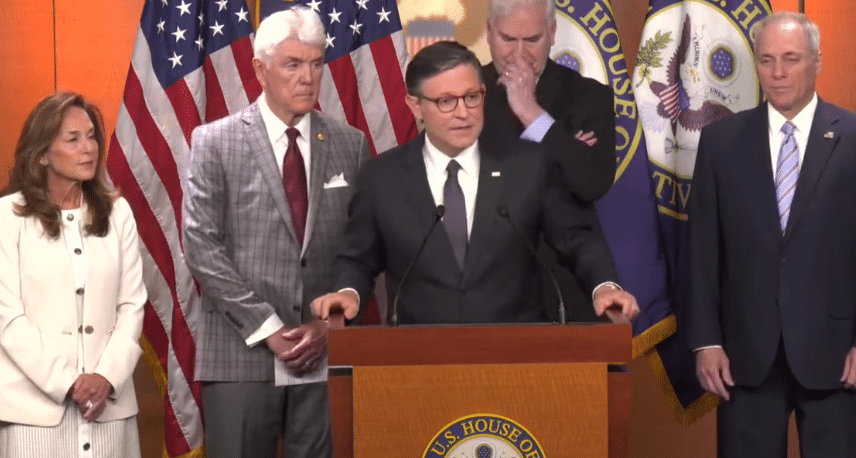
The Republican Party continues leading favorability over Democrats in the latest average of national polls in 2025, 41.7 percent to Democrats’ 34.1 percent, while both have relatively high unfavorables at 53.4 percent for the GOP and 59.4 percent for Democrats.
In the meantime, Democrats still lead the 2026 generic Congressional ballot, 46 percent to 42.1 percent, just a 3.9 percent lead.
In the past seven midterm elections dating back to 1998, the party that led favorability on or around Election Day ended up picking up seats in the House of Representatives, looking at Gallup’s historical tracking of the question.
In December 1998, Democrats led favorability over Republicans, 58 percent to 31 percent.
In November 2002, Republicans led favorability 54 percent to 48 percent.
In November 2006, Democrats led favorability 57 percent to 35 percent.
In November 2010, Republicans led favorability 45 percent to 43 percent.
In November 2014, Republicans led favorability 42 percent to 36 percent.
In January 2019, Democrats led favorability over Republicans 45 percent to 37 percent.
And in November 2022, Republicans led favorability over Democrat 42 percent to 39 percent.
And, the average of generic Congressional ballot polls also all predicted the winner of the past six midterm elections in 2002, 2006, 2010, 2014, 2018 and 2022 midterm elections.
In 2006, the average of polls had Democrats leading the generic Congressional ballot 52.1 percent to 40.6 percent, although that overstated the outcome a bit, with Democrats winning the House popular vote 52 percent to 44 percent.
In 2010, the average of polls had Republicans leading 50.7 percent to 41.3 percent, also overstated a bit, with the final outcome being 51.6 percent to 44.8 percent.
In 2014, the average of polls had Republicans ahead, 45.6 percent to 43.2 percent, and Republicans won with 51.4 percent to 45.7 percent.
In 2018, the average of polls had Democrats ahead, 49.7 percent to 42.4 percent, and Democrats won with 53.3 percent to 44.9 percent.
And in 2022, the average of polls had Republicans ahead 48 percent to 45.5 percent, and Republicans won 50.6 percent to 47.8 percent.
So, which is correct? That is, if in November 2026, Republicans still lead favorability and Democrats were leading the Congressional ballot, who would end up picking up seats in the House? Which is the stronger indicator?
In midterm elections dating back to 1906 through 2022, the party that occupied the White House lost seats in the House 27 out of 30 times, or 90 percent of the time, and in years with losses those averaged 34 seats. It was only overcome in 1934, 1998 and 2002, with the Great Depression, Monica Lewinsky and the Sept. 11, 2001 terrorist attacks acting as exigent events. Another edge case is 1962, wherein Democrats only lost three seats, and came within weeks of the Cuban Missile Crisis being resolved.
This is all James Madison’s constitutional scheme of periodic elections, wherein the opposition party, being out of power, has more a motivation to vote, and so they tend to do relatively better, picking up seats, but not always majorities. Keep going back to the people every two years was the idea for the House particularly, whereas only one-third of the Senate comes up every two years. The House is supposed to be the closest to the people.
Therefore, it is unsurprising that the popular vote itself a reliable gauge of which party wins the House majority. In 28 out of 30 midterm elections, or 93 percent of cases, the party that won the national popular vote for the House also won the majority for the House of Representatives, in 1906, 1910, 1918, 1922, 1926, 1930, 1934, 1938, 1946, 1950, 1954, 1958, 1962, 1966, 1970, 1974, 1978, 1982, 1986, 1990, 1994, 1998, 2002, 2006, 2010, 2014, 2018 and 2022.
The only exceptions were 1914, when Republicans won the popular vote but not a House majority, and 1942, when the same thing happened. Thos are primarily owed to the 100+ seat majorities Democrats had acquired in 1912 and 1940, making it very difficult to reclaim the gavel.
In modern polling, the generic ballot is closest proxy to the national popular vote, and which the average of polls has gotten correct in the past six cycles. Whereas favorability could be viewed as a gauge of confidence in one’s own party.
Now, Republicans are gearing up to run on law and order, immigration and an improving economy, while Democrats attempt to capitalize on President Donald Trump’s aggressive governing style and in favor of obstructing the President’s attempts to maintain the rule of law. Who is projecting confidence and who is projecting weakness?
While still more than a year away, the 2026 midterms are much closer than they should be. Democrats are behind. Usually for midterms where Democrats are favored in polls from 7 to 12 percentage points the past two such cycles, but now are only leading less than 4 percent. And every time a party measured below 40 percent approval, they lost that midterm cycle. So the Democrats are weak — and vulnerable.
What matters is what the numbers say very close to Election Day. But for now it looks like the 2026 race for the House could be close. As usual, stay tuned.
Robert Romano is the Executive Director at Americans for Limited Government Foundation.






